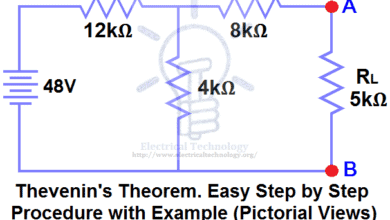What Happens if a Power Line Falls into the Ocean Water?
What Happens if a High-Voltage Power Line Falls into the Ocean, or a Battery or Toaster Comes into Contact with a Bathtub or Seawater?
The interaction between electricity and water is complex and depends on the specific situation. While electricity can travel through water, its range and effects decrease quickly due to resistance and dispersion in the ocean or seawater. Understanding this behavior is important for ensuring safety and preventing accidents involving electricity and water.
Whether it’s a live power line, a battery, or an appliance coming into contact with a bathtub, spa, pool or the ocean, taking proper precautions against electric shock drowning (the death of swimmers exposed to electric currents in the water) and to protect people, marine life, and infrastructure.
The following are the effects of electric shock on the human body based on electric current, voltage, and resistance.
- A current of up to 30 mA can be fatal, even for a short duration, especially under wet conditions.
- A current as low as 50 to 150 milliamps (mA) (equivalent to 0.05 to 0.15 amps) is sufficient to cause electrocution.
The resistance of the human body varies significantly:
-
- Wet conditions: Approximately 1,000 ohms.
- Dry conditions: Approximately 10,000 ohms.
Voltage levels that can cause harm:
-
- Dry conditions: As low as 50 volts.
- Wet conditions: As low as 25 volts, which is sufficient to shock a person.[/box]
What Happens if a HV Live Power Line Accidentally Falls into the Sea?
When a high-voltage power line accidentally comes into contact with the sea, the outcome depends on factors like the voltage, the salinity of the water, and the proximity to the point of contact.
Saltwater is an excellent conductor due to its high concentration of ions like sodium (Na+) and chloride (Cl-). If a live power line falls in seawater, a strong electrical mobility (moving of charged particles in electric field) spreads radially from the point of contact, creating a radial gradient of voltage which poses electrocution hazard. The danger zone depends on the voltage and current.
The water near the point of contact will experience the highest voltage. As the distance increases, the voltage drops, creating a gradient. This gradient can cause a dangerous electric shock to anyone or anything in its vicinity.
The risk of electrocution decreases with distance from the source because the voltage diminishes as the current disperses.
In addition, the immense current flowing into the water can cause localized heating and electrolysis, breaking water molecules into hydrogen and oxygen gases.
Moreover, the same effect has impacts on marine life i.e. marine animals close to the source can experience lethal shocks due to the electroshock zones. The flow of electricity could lead to electrolysis, breaking water into hydrogen and oxygen gases, which may result in small explosions or bubbles. Furthermore, it disrupts the ecosystem i.e. sustained electrical discharge could impact marine habitats by altering water chemistry.
In such cases, safety measures are taken to mitigate the hazardous situation. Utility companies implement automatic circuit breakers to detect faults and quickly shut down power, minimizing the hazard. During the hazardous case, public safety measures include keeping people away from the area until the power line is de-energized.
- Related Post: Will I Get an Electric Shock If I Touch the Ground Wire?
If We Put a Live Power Cable in the Sea, How Far Away Could It Electrocute Someone?
The distance at which electricity can harm someone in water depends on several factors:
- Voltage and Current: Higher voltages can propagate electrical currents over greater distances.
- Water Conductivity: Seawater, being highly conductive, allows electricity to travel farther compared to freshwater.
- Human Conductivity: The human body’s resistance (around 1,000 to 100,000 ohms, depending on conditions) determines how much current can flow through it.
The estimation and determination of exact area of danger zone is little bit complex due to multiple factors involved in this case. In case of voltage gradient (step potential), voltage decreases exponentially around the live cable.
For example, in high-voltage scenarios, the danger zone may extend several meters, but beyond that, the current dissipates enough to become relatively safe.
The dangerous range might extend up to several meters, but exact distances depend on the electrical load and water salinity. similarly, it depends on the amount of the lethal current levels i.e. currents as low as 0.1 amps can be fatal. People closer to the source face a higher risk.
- Related Post: Can the Neutral Wire Cause Electric Shock?
What Would Happen if We Connect a Battery to the Ocean?
A battery connected to the ocean would cause electrical current to flow between its terminals, with water acting as a conductive medium. As a result, connecting a battery to the ocean creates a small-scale electrochemical system i.e. electrophoresis (motion of charged particles relative to a fluid in a uniform electric field) in electrolysis as follows:
- At the negative terminal (cathode): Water molecules split into hydrogen gas and hydroxide ions.
- At the positive terminal (anode): Water splits into oxygen gas and hydrogen ions.
In case of low voltage batteries (e.g., 12V), the impact is minimal due to the relatively low energy output. During this process, electrolysis occurs, producing bubbles of hydrogen at the negative terminal and oxygen at the positive terminal. As a result, the current would not travel far due to the limited voltage of a typical battery. The resistive properties of water, even if salty, would quickly dissipate the energy
In case of high voltage batteries, higher voltages increase the risk of electroshock near the terminals. Over time, the electrodes may corrode due to chemical reactions with saltwater.
Continuous operation has environmental impacts and it could alter the local water chemistry, potentially harming marine life.
- Related Post: Why Can’t a 12V Car Battery Electrocute You?
What Happens if We Put Electric Wires in the Sea? Would Electricity Travel Around the World’s Oceans?
Electricity disperses in water through ions. However, the resistance of water (even saltwater) limits the current’s range. In other words, salty water is a good conductor of electricity but distilled water is not and pure water acts as an insulator to the flow of current. Water having dissolved electrolytes has conductance, hence, the energy dissipates rapidly due to the vast volume of water, preventing it from traveling significant distances.
If we connect a power supply to the sea or ocean, the circuit will complete through the phase wire and the conductive path provided by the water, which acts as a connection to the ground. This is similar to establishing a ground connection using the earth in remote areas, where the return current flows through the ground to complete the circuit. This is how oceans are used for returning current path in telecommunication cables.
Electricity cannot circle the globe through the ocean due to resistance. For instance: Saltwater has a resistivity of around 0.2 ohm-meters, which causes rapid energy loss. In this case, the current would be concentrated near the wire, creating a small danger zone. Beyond this zone, the voltage drops significantly.
The current has an effect within a range of 77.5 meters for a 120V supply and 110 meters for a 240V supply when in direct contact with saltwater in the ocean (refer to the solved example provided in the section below).
In case of underwater power transmission and distribution, subsea power cables use insulated conductors to transmit electricity over long distances without dissipating into the water.
Hence, it is not possible for a power supply connected to seawater in the UK to electrocute a person swimming at a beach in the U.S. or South Africa. This is because electricity dissipates rapidly in water due to resistance, limiting its range to the area near the point of contact.
5. What Happens if a Toaster Supplied by 120V or 240V Makes Contact with a Bathtub or Sea Water?
A toaster falling into a bathtub or seawater creates a serious hazard due to the direct contact of electricity with a conductive medium.
Water inside the toaster creates a short circuit, tripping the circuit breaker (if present). if not, the electrical current spreads through the water which poses electrocution hazard. If someone is in the water, they may receive a lethal shock depending on their proximity.
In a bathtub or pole without proper grounding, freshwater has higher resistance than seawater but still poses a deadly electrocution risk. The body, being a better conductor than water, may attract current, leading to severe injury or death.
In the sea, seawater’s conductivity amplifies the spread of electricity. The area of effect would be larger than in a bathtub, but the risk diminishes with distance due to dissipation.
For example: If an 120V toaster falls and connected to the seawater, where saltwater has a resistivity of 0.2 ohm-meter, the safe distance would be:
√((120 Volts) × (0.1 m toaster size) ÷ ((0.2 Ohm-m) × (10 mA/m2 of current density))) = 77.5 meters.
It means, the effect of current will be neutralized and terminated after 77.5 meters in case of 120V supply.
Similarly, solving the same case for 240V circuit, the safe distance is 110 meters.
- Related Post: AC or DC – Which One is More Dangerous And Why ?
How Far Can Electricity Travel Through Water?
The range of electricity in water is limited by factors influencing distance:
- Voltage and Current: Higher voltages travel farther before dissipating.
- Water Conductivity: Seawater enables electricity to travel farther than freshwater due to its ionic content. On the other hand, lower conductivity limits the range significantly in fresh water.
- Geometry of the Source: The presence of impurities or dissolved salts increases conductivity and range. Point sources create radial dispersion, while linear sources spread differently.
The typical range of seawater, dangerous electrical effects may extend up to 10 meters from a high-voltage source. In case of freshwater, the range is typically much shorter due to higher resistivity.
For example, a high-voltage power source in seawater could create a dangerous electric field extending several meters, but the energy diminishes quickly due to resistance.
As calculated in the example given in the above section, the safe distance beyond which the current is neutralized is approximately 77.5 meters for a 120V supply and 110 meters for a 240V supply when in contact with saltwater.
- Related Post: Which One is More Dangerous? 120V or 230V and Why?
- High-voltage electricity in water creates a localized danger zone, with risks decreasing rapidly with distance.
- Saltwater, due to its high conductivity, spreads electricity further than freshwater.
- Small-scale electrical sources like batteries have minimal impact on large water bodies but can still cause localized effects.
- The idea of electricity traveling through the world’s oceans is a myth due to resistance and energy dissipation.
- Household appliances in water create severe risks of electrocution, even at low voltages.
Related Posts and Resources:
- What Happens When You Touch an Electrical Busbar?
- What Happens if a Battery is Connected to the AC Supply?
- Why Can’t We Store AC in Batteries instead of DC?
- What Happens to the Battery with Reverse Polarity Wiring Connection
- What Happens When an AC Line Touches a DC Line?
- Why Don’t Birds and Squirrels Get Electrocuted on Power Lines?
- Why Don’t Bug Zappers and Fly Swatter Bats Kill Humans?
- What are the Colored Aerial Marker Balls on Power Lines For?
- Which One is More Dangerous? 50Hz or 60Hz in 120V/230V & Why?
- Why Do The Positive And Negative Wires Spark When Touched?
- What Happens When an AC Line Touches a DC Line?
- Why is the Grounding Wire Bare and Not Insulated?
- What Happens if We Connect a Polar Capacitor the Wrong Way?
- Why Don’t Birds and Squirrels Get Electrocuted on Power Lines?
- Is Lightning AC or DC ?








how come the negative side of the battery is both creat the oxygen and hydrogen at the same time in the battery article. please correct it.